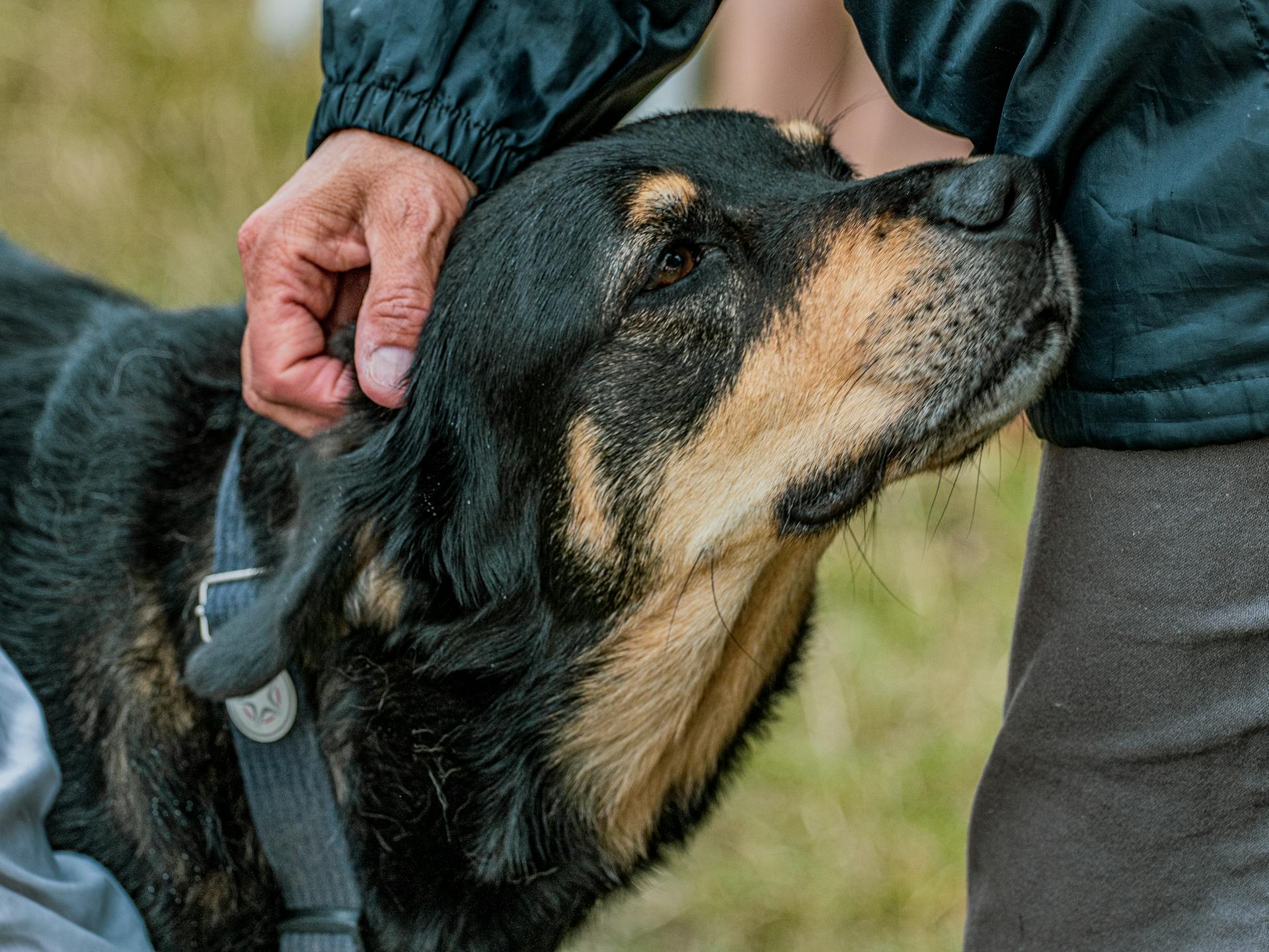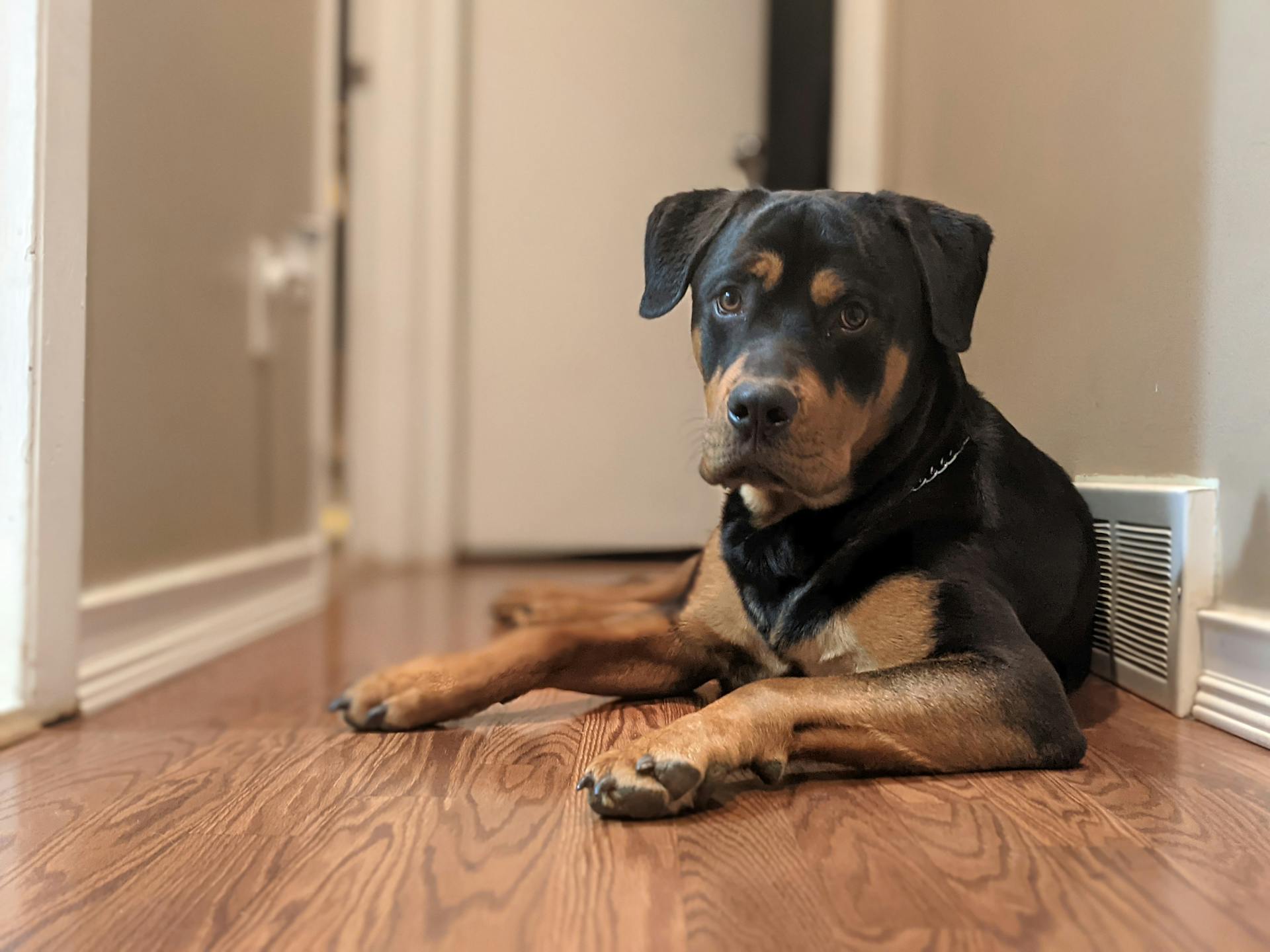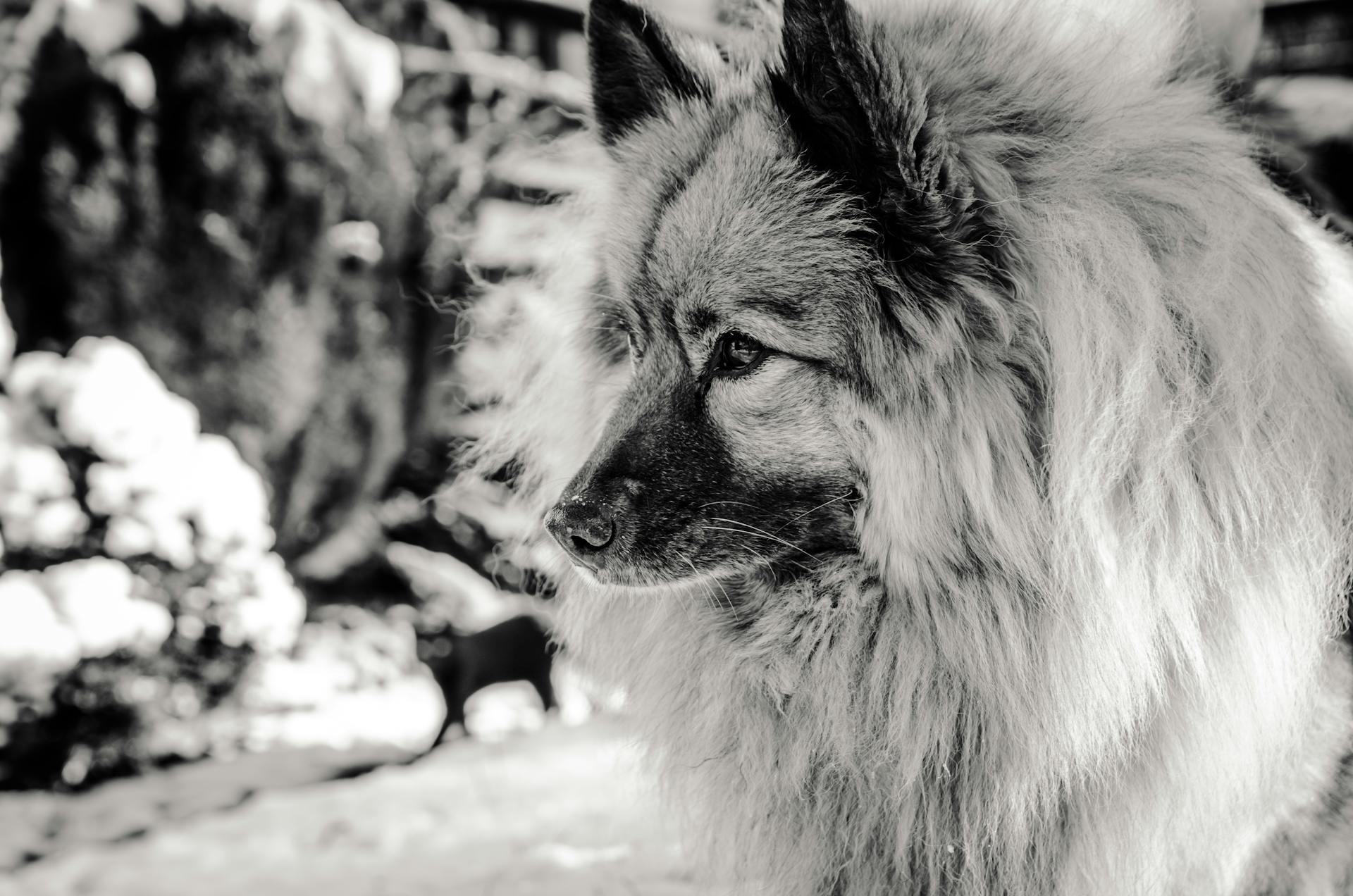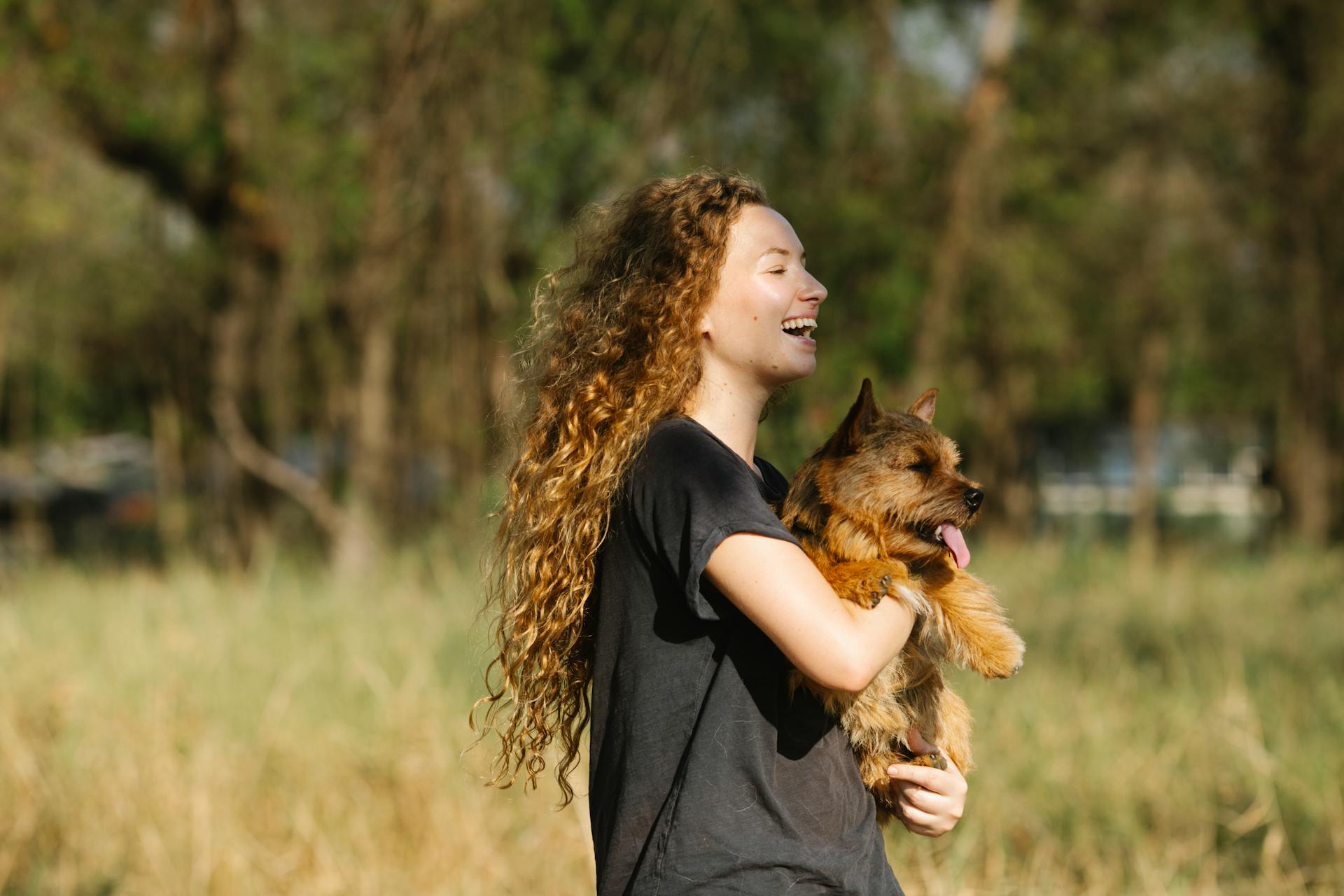
Adult Rottweilers are a unique breed that requires careful consideration before bringing one home. They can live up to 8-11 years, but their lifespan can vary depending on factors like diet and exercise.
Rottweilers are naturally protective of their families, making them excellent guard dogs. However, this also means they can be wary of strangers, so early socialization is key.
With proper training, adult Rottweilers can learn to obey commands and behave well in public. They're intelligent and eager to please, but they can be stubborn at times.
Physical Characteristics
Adult Rottweilers are a sight to behold, with their robust bodies and sturdy frames. They're built for strength and confidence, with a square muzzle that's prone to drooling due to their loose flews.
Their strong, stocky bodies are slightly longer than they are tall, making them a formidable presence. Male Rottweilers typically range from 24 to 27 inches in height.
Rottweilers have a distinctive coat pattern, with a "saddle" shape defined by a lighter coloring on their stomach, legs, paws, and face. Their coat is a smooth dark color, with three recognized colors: black and mahogany, black and tan, and black and rust.
Their dense coat requires regular bathing to minimize shedding and maintain healthy skin and coat. This should be done every four to eight weeks, depending on lifestyle.
Male Rottweilers typically weigh between 95 and 135 pounds, while females weigh between 80 and 115 pounds.
Worth a look: Morkie Black and White
Temperament and Personality
Adult Rottweilers are known for their calm and confident nature, making them a great companion for many families. They're generally quiet and gentle, but also have a strong work ethic and desire to protect their family and property.
Their temperament is influenced by their breeding history as guard dogs, which can sometimes make them come off as cautious and reserved around new people or situations. However, with proper socialization and training, they can become incredibly loving and playful dogs.
Rottweilers are intelligent and adaptable, making them highly trainable, but they can also be stubborn at times. They require firm and consistent discipline, but harsh punishment is not recommended.
A key factor in determining a Rottweiler's temperament is their socialization. Puppies that are exposed to many different people, sights, sounds, and experiences early on are more likely to grow up to be well-rounded and confident dogs.
Here are some key characteristics of a Rottweiler's temperament:
- Calm and confident
- Quiet and gentle
- Strong work ethic and desire to protect family and property
- Intelligent and adaptable
- Highly trainable, but can be stubborn at times
Overall, adult Rottweilers are wonderful companions for families who are willing to invest time and effort into their training and socialization. With the right care and attention, they can become loving and loyal pets that bring joy and companionship to their owners.
Health and Care
Adult Rottweilers require regular exercise to stay healthy. At least 60 minutes of exercise every day is recommended, which can be broken down into 10-20 minute walks and playtime.
A Rottweiler's energy level can range from couch potato to whirlwind, so it's essential to tailor your exercise routine to your dog's needs. Moderately active Rottweilers will appreciate a couple of 10-20 minute walks each day, while more energetic Rotties may need longer exercise times and more structured activities.
To prevent unwanted behaviors like chewing furniture, Rottweilers need enough mental stimulation. This can be achieved through playtime, training, and interactive toys. Regular mental stimulation will keep your Rottweiler engaged and prevent boredom.
Some common health issues in Rottweilers include hip dysplasia, elbow dysplasia, and osteochondrosis dissecans (OCD). Regular health check-ups with your vet are crucial to detect any potential problems early on.
Worth a look: Common Health Issues with Rottweilers
Common Health Conditions
Rottweilers are prone to certain health issues that can affect their quality of life. Hip dysplasia is a common problem, where the thighbone doesn't fit correctly into the hip joint, leading to arthritis.
Discover more: Hip Dysplasia in Rottweilers

Regular health check-ups are crucial to catch these issues early on. Hip dysplasia symptoms include pain in the hip, difficulty rising, unstable hip joints, or limping.
Elbow dysplasia is another concern, which affects the elbow joint and can cause swelling, lameness, and an abnormal gait. Some Rottweilers may also experience eye disorders, such as entropian and ectropion, which can be painful and require surgical correction.
Gastric dilatation-volvulus (GDV), also known as bloat, is a life-threatening condition that can occur in deep-chested breeds like Rottweilers. Symptoms include unproductive retching, saliva vomiting, discomfort, arched back, swollen abdomen, and restlessness.
Here are some common health conditions that Rottweilers may experience:
It's essential to take your Rottweiler to the vet for regular check-ups and to monitor their health closely. With proper care and attention, you can help prevent or manage these common health conditions.
Take a look at this: Shiba Inu Dog Health Problems
CCL Rupture
CCL Rupture is a common injury in Rottweilers. It's similar to a human's ACL tear, but in dogs, it's caused by their large size and high energy levels.
Rottweilers are prone to CCL ruptures due to their active lifestyle. If your Rottweiler is prone to CCL ruptures, it's essential to take preventative measures.
Maintaining a healthy weight is crucial in reducing the risk of CCL rupture. A healthy weight can also help alleviate other health issues.
Avoiding high-impact activities is vital in preventing CCL ruptures. This includes activities like running on hard surfaces or playing tug-of-war.
Engaging in low-impact exercise is a great way to reduce the risk of CCL rupture. Activities like walking, swimming, and nose work are excellent alternatives.
Here are some tips to reduce your Rottweiler's risk of CCL rupture:
- Avoid high-impact activities
- Maintain a healthy weight
- Engage in low-impact exercise
Dog Care
Rottweilers need to live in the home with their people, as they can become bored, destructive, and aggressive if left alone in a backyard all the time.
Their energy level ranges from couch potato to whirlwind, so it's essential to tell the breeder what kind of energy level suits you when choosing a puppy. This will help you choose the best puppy for your lifestyle.
Explore further: Aussiedoodle Energy Level
A Rottweiler is a homebody, but they require a fenced yard to protect them from traffic and other dogs and strangers who come onto their property. An underground electronic fence won't keep them in if they really want to get out.
Rottweilers need at least 60 minutes of exercise every day, which can include walks, playing with balls, and going hiking. More energetic Rotties may need longer exercise times and more structured activities.
Their athleticism, intelligence, and trainability make them well-suited to agility and obedience competition, as well as tracking, therapy work, and their traditional job, pulling a cart or wagon.
A Rottweiler's coat is short and black with tan to mahogany accents, and they often have a bobtail, although this isn't genetic.
Here's a breakdown of a Rottweiler's daily needs:
This will help ensure your Rottweiler stays engaged and prevents unwanted behaviors, such as chewing your furniture.
Dog Nutrition
Feeding your adult Rottweiler is crucial to maintaining their overall health and happiness. A high-quality dry food is essential, and the recommended daily amount is 4 to 10 cups, divided into two meals.
The quality of dog food you choose makes a significant difference, and better food will go further in nourishing your dog, requiring less quantity. To keep your Rottweiler in good shape, measure their food and feed them twice a day, rather than leaving food out all the time.
A Rottweiler's waist should be visible, and you should be able to feel their ribs without pressing hard. If you can't, they need less food and more exercise. Your veterinarian can help you choose the best food option for your dog, and ensure you're feeding the right life stage food – either adult dog food or puppy food, depending on their age.
Rottweilers are individuals, just like people, and their feeding needs vary depending on their size, age, build, metabolism, and activity level. A highly active dog will need more food than a couch potato dog.
Here's a rough guide to portion sizes:
Remember, it's essential to consult with your veterinarian to determine the best feeding schedule and portion sizes for your individual Rottweiler. They can assess your dog's body condition and provide an individualized caloric intake recommendation.
Grooming and Maintenance
As an adult Rottweiler owner, you know that grooming is a crucial part of their care. Rottweilers have a short double coat that sheds twice a year, so be prepared for regular brushing to keep loose hair under control. Weekly brushing with a firm bristle brush will help remove dead hair and distribute skin oils.
Rottweilers are not hypoallergenic, so if you or a family member has allergies, you may want to consider this before bringing a Rottie into your home. They shed quite a bit, but their grooming needs are relatively low-maintenance compared to fluffier breeds.
Consider reading: Short Hair Chorkie
Grooming Guide
Rottweilers have a short double coat that sheds twice a year, so be prepared for regular brushing sessions.
You'll want to brush your Rottweiler weekly with a firm bristle brush to remove dead hair and distribute skin oils. This will help keep their coat healthy and clean.
Their undercoat depends on the climate, so if you live in a warmer area, your Rottweiler might have less of an undercoat than one living in a colder climate.
Discover more: Dog Blowing Coat in Winter
Brush their teeth at least two or three times a week to remove tartar buildup and bacteria. Daily brushing is even better to prevent gum disease and bad breath.
Rottweilers have a unique marking pattern, with common markings including two triangle-shaped markings on their chest, dots above their eyes, and a stripe on each side of their muzzle.
Here's a breakdown of their grooming needs:
Their shedding can be quite heavy, so be prepared for regular brushing sessions to keep their fur under control.
Ear Care
Taking care of your Rottweiler's ears is crucial, especially with their floppy, folded-over ears that can trap debris and moisture. Regular cleaning with a veterinary-approved cleaner can prevent infections from setting in.
Their ears are prone to getting dirty, so make it a habit to clean them regularly, ideally once a week.
Cleaning their ears can be a bit tricky, but with the right tools and a gentle touch, it's a breeze.
Worth a look: Doberman Pinscher Docked Ears
Training and Behavior
Training and behavior is a crucial aspect of owning an adult Rottweiler. They are highly intelligent and eager to please, making them quick learners.
Rottweilers have a natural instinct to be protective, which can manifest as barking in unfamiliar situations or when meeting new people. Early socialization and consistent training can help mitigate this behavior.
Positive reinforcement training is recommended, as it provides consistent and long-lasting behavioral memory. This method encourages good behavior and discourages bad behavior.
To keep your adult Rottweiler engaged and happy, provide at least one hour of exercise per day, along with mental stimulation through training sessions, playtime, and toys. Without this stimulation, they can grow destructive and anxious.
Behavior
Rottweilers were originally bred as working and guardian dogs, so they have a natural instinct to be protective. This can lead to barking habits in unfamiliar situations or when meeting new people.
Socializing your Rottweiler puppy early and consistently is crucial for having a well-mannered dog. Positive reinforcement and rewards are essential for good behavior.
Rottweilers need at least one hour of exercise per day to prevent boredom, which can lead to undesirable behaviors like excessive barking or chewing.
Rottweilers are smart and eager to please, making them quick learners of new commands. Positive reinforcement is the recommended training method.
Begin socializing your Rottweiler puppy as soon as you bring them home, introducing them to new environments, people, and animals throughout their life. This will help your pup learn that new things don't need to be scary.
Rottweilers excel at obedience training and enjoy having a job to do throughout the day. They're highly intelligent and trainable, ranking ninth in Stanley Coren's list of most intelligent dog breeds.
Without regular mental stimulation, Rottweilers can grow destructive and anxious during the day. They need activities that challenge their minds, such as training sessions, playtime, and puzzle toys.
Fun Activities
One of the best ways to strengthen the bond between you and your dog is to engage in fun activities together. Physical exercise is essential for dogs, and activities like fetch and agility training can help burn off excess energy.
A different take: Activities for Dogs with High Prey Drive
Dogs thrive on mental stimulation, and games like hide-and-seek and scent work can challenge their problem-solving skills and keep them engaged. These activities can help reduce boredom and destructive behavior in dogs.
Some dogs are naturally more energetic than others, and high-energy breeds like Labradors and Australian Shepherds require more exercise than low-energy breeds like Bulldogs and Pugs. Regular physical activity can help reduce stress and anxiety in dogs.
Interactive toys and puzzle feeders can provide mental stimulation for dogs, keeping them engaged and active even when you're not around. These toys can help reduce separation anxiety and destructive behavior in dogs.
See what others are reading: Dog Toys for Rottweilers
General Information
Adult Rottweilers typically weigh between 85 and 130 pounds. They can live up to 8-11 years, which is a relatively long lifespan for a large breed.
Rottweilers are a medium to large breed, with adults reaching heights of 24-27 inches at the shoulder. Their size and weight make them a formidable presence, but also require regular exercise to maintain a healthy weight and prevent obesity.
For your interest: Breed Rottweilers
Adult Rottweilers need at least 30 minutes of exercise per day, which can include walks, runs, and playtime in the yard. This will help keep them physically and mentally stimulated.
Here are some general health issues to be aware of in adult Rottweilers:
General Information
Rottweilers are a breed of working dog with origins dating back to the Roman Empire.
Their name comes from the town of Rottweil, Germany, where they were left by Roman legions as cattle-driving dogs.
Rottweilers have served as guard dogs, butcher's dogs, draft dogs, rescue dogs, and more recently as police dogs.
They were also among the first guide dogs for the blind and have distinguished themselves as capable search-and-rescue workers.
Despite their many roles, the breed has remained relatively unchanged since its first German breed standard in 1901.
The breed is often affectionately known as "Rotties".
Take a look at this: Roman Rottweilers
Pet Breed Information
Rottweilers are a medium to large breed of dog, typically weighing between 75-135 pounds and standing between 22-27 inches tall at the shoulder.
Their size requires regular exercise to stay healthy and happy. A daily walk or run is a great way to provide them with the physical and mental stimulation they need.
Rottweilers have a short, dense coat that requires minimal grooming. A weekly brush and occasional nail trim are all that's needed to keep them looking their best.
They are a relatively long-lived breed, with an average lifespan of 8-11 years. However, with proper care and attention, some Rottweilers have been known to live up to 13 years or more.
Here are some common health issues that can affect Rottweilers:
- Hip dysplasia
- Elbow dysplasia
- Heart problems
- Cancer
Regular veterinary check-ups and a healthy diet can help prevent or manage these conditions.
Frequently Asked Questions
Are Rottweilers good house dogs?
Yes, Rottweilers can make great house dogs with proper training and care. With early socialization and consistent training, they can thrive in a family home.
Why are Rottweilers so clingy?
Rottweilers are clingy due to their strong desire for companionship and attention from their owners. This loyal nature can sometimes lead to separation anxiety if left alone.
Sources
- https://www.dogster.com/dog-breeds/types-of-rottweiler
- https://dogtime.com/dog-breeds/rottweiler
- https://www.petmd.com/dog/breeds/rottweiler
- https://www.greencrossvets.com.au/pet-library/dogs/breed-guides/rottweiler-owners-guide/
- https://www.petscreening.com/blog/rottweiler-temperament-a-dog-owners-guide
Featured Images: pexels.com


